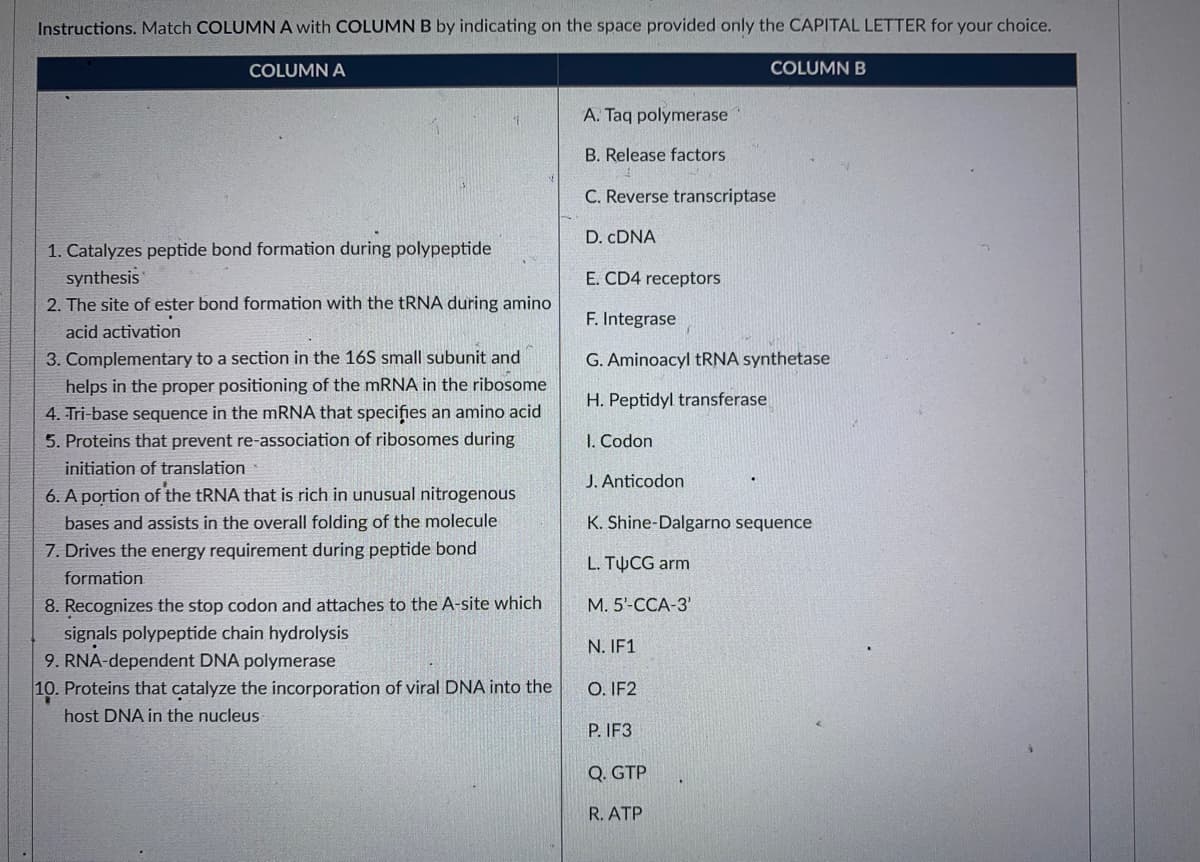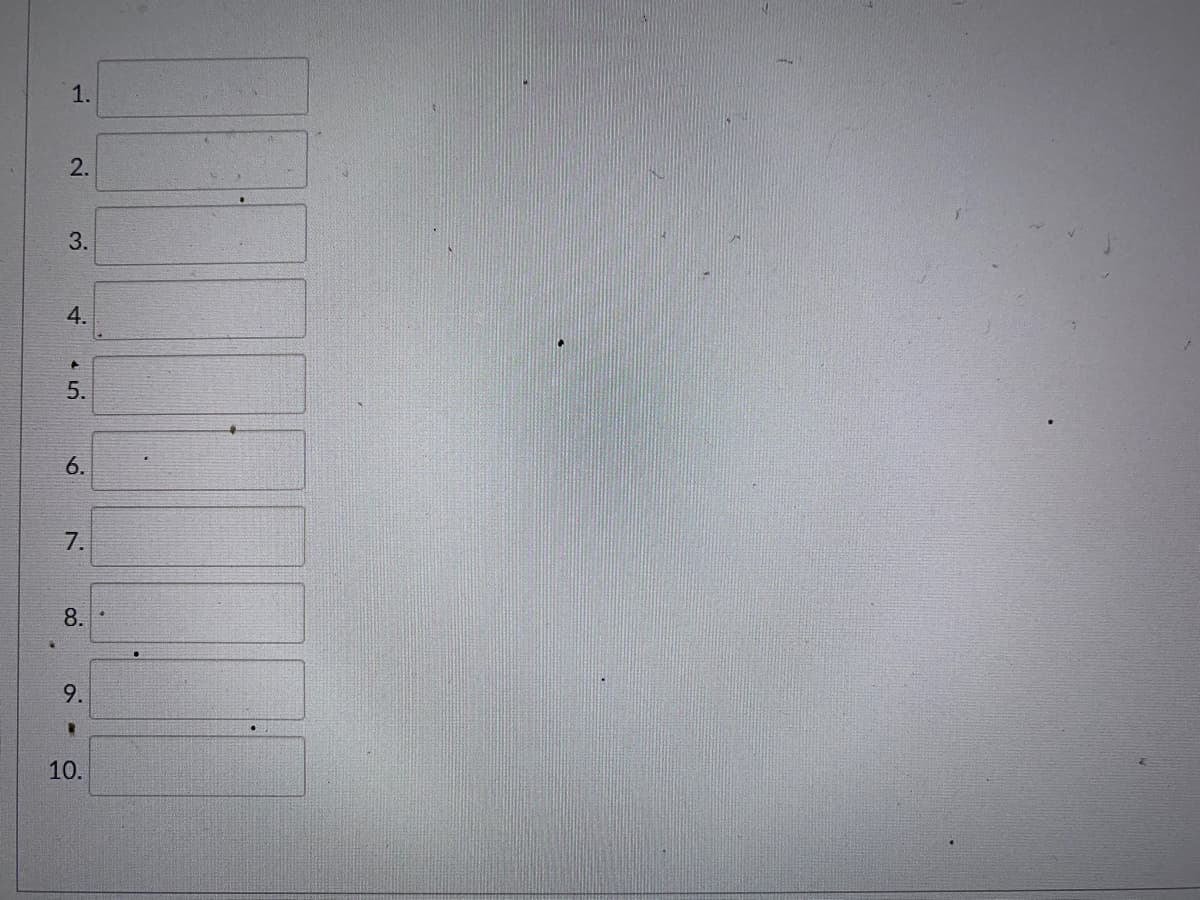A. Taq polymerase B. Release factors C. Reverse transcriptase D. CDNA 1. Catalyzes peptide bond formation during polypeptide synthesis 2. The site of ester bond formation with the tRNA during amino E. CD4 receptors F. Integrase acid activation 3. Complementary to a section in the 16S small subunit and G. Aminoacyl tRNA synthetase helps in the proper positioning of the mRNA in the ribosome 4. Tri-base sequence in the mRNA that specifies an amino acid 5. Proteins that prevent re-association of ribosomes during H. Peptidyl transferase I. Codon initiation of translation J. Anticodon 6. A portion of the TRNA that is rich in unusual nitrogenous bases and assists in the overall folding of the molecule K. Shine-Dalgarno sequence 7. Drives the energy requirement during peptide bond L. TUCG arm formation 8. Recognizes the stop codon and attaches to the A-site which signals polypeptide chain hydrolysis М.5-ССА-3' N. IF1 9. RNA-dependent DNA polymerase 10. Proteins that catalyze the incorporation of viral DNA into the O. IF2 host DNA in the nucleus P. IF3 Q. GTP R. ATP
A. Taq polymerase B. Release factors C. Reverse transcriptase D. CDNA 1. Catalyzes peptide bond formation during polypeptide synthesis 2. The site of ester bond formation with the tRNA during amino E. CD4 receptors F. Integrase acid activation 3. Complementary to a section in the 16S small subunit and G. Aminoacyl tRNA synthetase helps in the proper positioning of the mRNA in the ribosome 4. Tri-base sequence in the mRNA that specifies an amino acid 5. Proteins that prevent re-association of ribosomes during H. Peptidyl transferase I. Codon initiation of translation J. Anticodon 6. A portion of the TRNA that is rich in unusual nitrogenous bases and assists in the overall folding of the molecule K. Shine-Dalgarno sequence 7. Drives the energy requirement during peptide bond L. TUCG arm formation 8. Recognizes the stop codon and attaches to the A-site which signals polypeptide chain hydrolysis М.5-ССА-3' N. IF1 9. RNA-dependent DNA polymerase 10. Proteins that catalyze the incorporation of viral DNA into the O. IF2 host DNA in the nucleus P. IF3 Q. GTP R. ATP
Human Anatomy & Physiology (11th Edition)
11th Edition
ISBN:9780134580999
Author:Elaine N. Marieb, Katja N. Hoehn
Publisher:Elaine N. Marieb, Katja N. Hoehn
Chapter1: The Human Body: An Orientation
Section: Chapter Questions
Problem 1RQ: The correct sequence of levels forming the structural hierarchy is A. (a) organ, organ system,...
Related questions
Topic Video
Question
13

Transcribed Image Text:Instructions. Match COLUMN A with COLUMN B by indicating on the space provided only the CAPITAL LETTER for your choice.
COLUMN A
COLUMN B
A. Taq polymerase
B. Release factors
C. Reverse transcriptase
D. CDNA
1. Catalyzes peptide bond formation during polypeptide
synthesis
2. The site of ester bond formation with the tRNA during amino
E. CD4 receptors
F. Integrase
acid activation
3. Complementary to a section in the 16S small subunit and
helps in the proper positioning of the mRNA in the ribosome
G. Aminoacyl tRNA synthetase
H. Peptidyl transferase
4. Tri-base sequence in the mRNA that specifies an amino acid
5. Proteins that prevent re-association of ribosomes during
I. Codon
initiation of translation
J. Anticodon
6. A portion of the TRNA that is rich in unusual nitrogenous
bases and assists in the overall folding of the molecule
K. Shine-Dalgarno sequence
7. Drives the energy requirement during peptide bond
L. TUCG arm
formation
8. Recognizes the stop codon and attaches to the A-site which
M. 5'-CCA-3'
signals polypeptide chain hydrolysis
9. RNA-dependent DNA polymerase
10. Proteins that catalyze the incorporation of viral DNA into the
N. IF1
O. IF2
host DNA in the nucleus
P. IF3
Q. GTP
R. ATP

Transcribed Image Text:1.
2.
3.
4.
5.
6.
7.
8.
9.
10.
Expert Solution
This question has been solved!
Explore an expertly crafted, step-by-step solution for a thorough understanding of key concepts.
Step by step
Solved in 2 steps

Knowledge Booster
Learn more about
Need a deep-dive on the concept behind this application? Look no further. Learn more about this topic, biology and related others by exploring similar questions and additional content below.Recommended textbooks for you

Human Anatomy & Physiology (11th Edition)
Biology
ISBN:
9780134580999
Author:
Elaine N. Marieb, Katja N. Hoehn
Publisher:
PEARSON

Biology 2e
Biology
ISBN:
9781947172517
Author:
Matthew Douglas, Jung Choi, Mary Ann Clark
Publisher:
OpenStax

Anatomy & Physiology
Biology
ISBN:
9781259398629
Author:
McKinley, Michael P., O'loughlin, Valerie Dean, Bidle, Theresa Stouter
Publisher:
Mcgraw Hill Education,

Human Anatomy & Physiology (11th Edition)
Biology
ISBN:
9780134580999
Author:
Elaine N. Marieb, Katja N. Hoehn
Publisher:
PEARSON

Biology 2e
Biology
ISBN:
9781947172517
Author:
Matthew Douglas, Jung Choi, Mary Ann Clark
Publisher:
OpenStax

Anatomy & Physiology
Biology
ISBN:
9781259398629
Author:
McKinley, Michael P., O'loughlin, Valerie Dean, Bidle, Theresa Stouter
Publisher:
Mcgraw Hill Education,

Molecular Biology of the Cell (Sixth Edition)
Biology
ISBN:
9780815344322
Author:
Bruce Alberts, Alexander D. Johnson, Julian Lewis, David Morgan, Martin Raff, Keith Roberts, Peter Walter
Publisher:
W. W. Norton & Company

Laboratory Manual For Human Anatomy & Physiology
Biology
ISBN:
9781260159363
Author:
Martin, Terry R., Prentice-craver, Cynthia
Publisher:
McGraw-Hill Publishing Co.

Inquiry Into Life (16th Edition)
Biology
ISBN:
9781260231700
Author:
Sylvia S. Mader, Michael Windelspecht
Publisher:
McGraw Hill Education